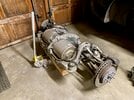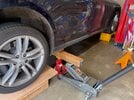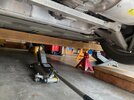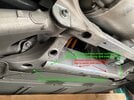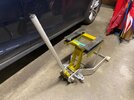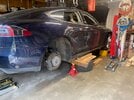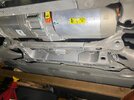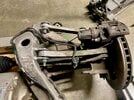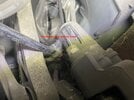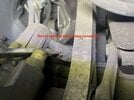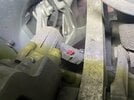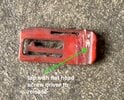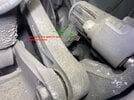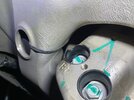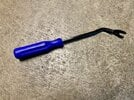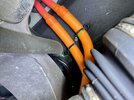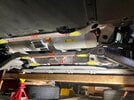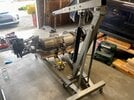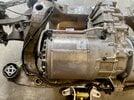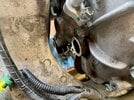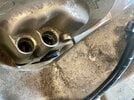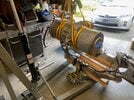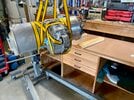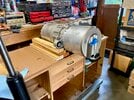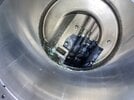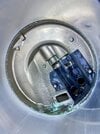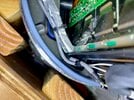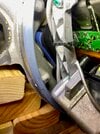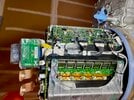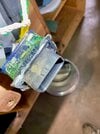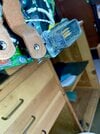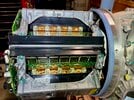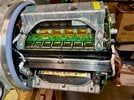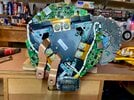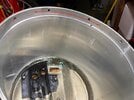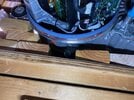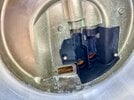Post #2
Draining Coolant
Good to clamp the hose to avoid draining excess coolant from rest of the system. Use hose clamps (I had vice grips combined with some rubber pads). I then plugged the hose with a plastic cap and rubber stopper (hose is ~3/4 ID, I believe the rubber stopper I used was #3 with 15/16" on the large end diameter). Also use 2 buckets to catch both inlet and outlet as more will drain after opening both up. Not too much coolant came out of LDU (I did spill a little) After draining, capped it with dish washing rubber glove cut finger tips and zip tied for security (Avoid making a mess on rest of the subframe steps)
Might also route the driver side hose upwards on the side of the subframe so it doesn't get in the way during the drop.
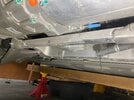
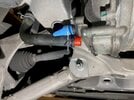
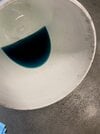 Draining the Gear Oil
Draining the Gear Oil
About 1.5qt total. Both my drain and fill magnetic plug had some mud on it (30k mile total on the LDU)
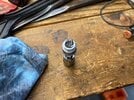 Dropping the Subframe 3 inches
Dropping the Subframe 3 inches
Need to drop 3 inches to gain access to release the HV cable from the inverter, HV cable bracket, and grounding wire. I used the motorcycle jack for this purpose. Removed the top jack platform for greater stability. Center of gravity is heavier on the motor side (driver side) so need to offset the jack accordingly.
Used a thick plastic binder sheet to protect the rear subframe wiring harness during the drop. There is barely any clearance in front and rear of the subframe to exit. And the chassis screw tabs for the mid aero shield can be easily smashed in the front of subframe (subframe actually need to move 1/2 cm backwards to clear) and damage the wiring harness in the rear.
I pulled the 2 passenger side wiring harness connectors to clear any body/frame pinch points. I pushed the 2 driver side wiring harness connector above the subframe beam to be safe during the drop.
Furthermore, motorcycle jacks do not drop vertically, it will angle forward as it drops. So I repeated the following steps
- pull subframe towards back of the car to provide 1/2" clearance in front of the subframe from the mid aero shield tab (thought about cutting it off haha) Check the rear subframe harness is safe (will gain clearance as motorcycle jack drops)
- lower subframe 1/2 inch.
- repeat
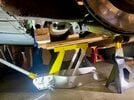
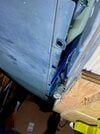
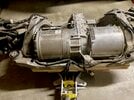
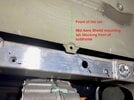 Remove the shock mount bolt
Remove the shock mount bolt
After 3-4 inch drop, can knock out this bolt with a hammer and a short (2-3”) 1/4” ratchet/socket extension).
Releasing the HV Cables
Cables are secured to the inverter casing with a black plastic clip with 4 fingers that grab at evenly space 90 degrees. Release the fingers 1 at a time and pull that side of the clip slightly upwards. Then rotate 90 degrees to get the next finger. Need to release all 4 fingers to pull up the black plastic clip completely. Then a big flat head should be able to pry up the wire from the housing if you don't have salted roads or flooded car. Another person helping to pull back the wheel liner is helpful to create more space and remove the sharp liner edge pressed against the arm.
I labeled on of the cables (B-) to avoid mixing them up later
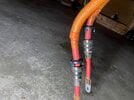 Dropping subframe all the way
Dropping subframe all the way
I did this in a couple of phases. Each phase 3-4 inches with additional stands for safety (jack stands under subframe locations, some wood below the plywood on motor cycle jack) just to ensure motorcycle jack could handle the weight and balance. Once I got the motor cycle jack in proper center of gravity (bias towards driver side where the heavier motor is), the control was quite good.
Initially, I had the motor cycle jack centered on the centerline of the car and subframe was leaning to driver side during the drop. Use a jack under driver side control arm to lift up that side of the subframe. Dropped the whole subframe plywood assembly onto wooden standing blocks (2 4x6s stacked on each side of the jack) Shifted jack toward driver side and found center of gravity and balance)
Don't forget to drop 1/2" at a time while pulling the jack backwards 1/2" until front/rear of the subframe and the wiring harness clears the bottom of the car chassis. 2 people is really helpful in this process. One to control the jack, the other to spot front and rear subframe clearance.
Jacking up the car 1-2 inch to clear the subframe+LDU from under the car
My motor cycle jack provided 14" of lift. With the 1/2" plywood and 2x4 padding blocks, needed another 1-2 inches to clear the bottom of the car. Put the jacks on each side of the cross beam that was used to put car on jack stands to gain the necessary clearance.
